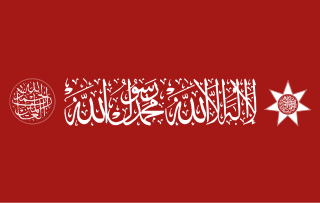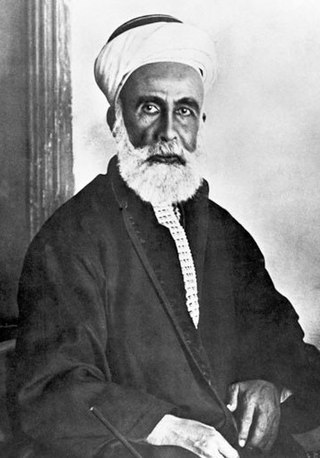
The history of Saudi Arabia as a nation state began with the emergence of the Al Saud dynasty in central Arabia in 1727 and the subsequent establishment of the Emirate of Diriyah. Pre-Islamic Arabia, the territory that constitutes modern Saudi Arabia, was the site of several ancient cultures and civilizations; the prehistory of Saudi Arabia shows some of the earliest traces of human activity in the world.

The Hashemites, also House of Hashim, are the royal family of Jordan, which they have ruled since 1921, and were the royal family of the kingdoms of Hejaz (1916–1925), Syria (1920), and Iraq (1921–1958). The family had ruled the city of Mecca continuously from the 10th century, frequently as vassals of outside powers, and ruled the thrones of the Hejaz, Syria, Iraq, and Jordan following their World War I alliance with the British Empire.

Taif is a city and governorate in the Province of Makkah in Saudi Arabia. Located at an elevation of 1,879 m (6,165 ft) in the slopes of the Hijaz Mountains, which themselves are part of the Sarat Mountains, the city has a population of 563,282 people in 2022, making it one of the most populous cities in the kingdom.

Hussein bin Ali al-Hashimi was an Arab leader from the Banu Qatadah branch of the Banu Hashim clan who was the Sharif and Emir of Mecca from 1908 and, after proclaiming the Great Arab Revolt against the Ottoman Empire, King of the Hejaz, even if he refused this title, from 1916 to 1924. He proclaimed himself Caliph after the abolition of the Ottoman Caliphate in 1924 and stayed in power until 1925 when Hejaz was invaded by the Saudis. His Caliphate was opposed by the British and French empires, the Zionists and the Wahhabis alike. However, he received support from a large part of the Muslim population of that time and from Mehmed VI. He is usually considered as the father of modern pan-Arabism.

The Arab Revolt, also known as the Great Arab Revolt, was an armed uprising by the Hashemite-led Arabs of the Hejaz against the Ottoman Empire amidst the Middle Eastern theatre of World War I.

The Hashemite Kingdom of Hejaz was a state in the Hejaz region of Western Asia that included the western portion of the Arabian Peninsula that was ruled by the Hashemite dynasty. It was self-proclaimed as a kingdom in June 1916 during the First World War, to be independent from the Ottoman Empire, on the basis of an alliance with the British Empire to drive the Ottoman Army from the Arabian Peninsula during the Arab Revolt.
The Damascus Protocol was a document given to Faisal bin Hussein on 23 May 1915 by the Arab secret societies al-Fatat and al-'Ahd on his second visit to Damascus during a mission to consult Turkish officials in Constantinople.

Ömer Fahrettin Türkkan (1868-1948), commonly known as Fakhri Pasha and nicknamed the Defender of Medina, was a Turkish career officer who commanded Ottoman forces and served as governor of Medina from 1916 to 1919. His British and Arab opponents nicknamed him "The Lion of the Desert" and "The Tiger of the Desert" due to his determined defence of Medina from 10 June 1916 to 10 January 1919 during World War I.
The siege of Medina lasted from 10 June 1916 to 10 January 1919, when Hejazi Arab rebels surrounded the Islamic holy city, which was then under the control of the Ottoman Empire.

The Battle of Mecca occurred in the Muslim holy city of Mecca in June and July 1916. On June 10, the Sharif of Mecca, Hussein bin Ali, the leader of the Banu Hashim clan, started a revolt against the Ottoman Caliphate from this city. The Battle of Mecca was part of the Arab Revolt of World War I.

The Arab Revolt started by Sherif Hussein ibn Ali had a series of campaigns, starting from Mecca in June 1916. Here is a list of these campaigns:

The Sharifian Army, also known as the Arab Army, or the Hejazi Army was the military force behind the Arab Revolt which was a part of the Middle Eastern theatre of World War I. Sharif Hussein bin Ali of the Kingdom of Hejaz, who was proclaimed "Sultan of the Arabs" in 1916, led the Sharifian Army in a rebellion against the Ottoman Empire with the ultimate goal of uniting the Arab people under an independent government. Aided both financially and militarily by the British, Hussein's forces gradually moved north through the Hejaz and, fought alongside the British-controlled Egyptian Expeditionary Force, eventually capturing Damascus. Once there, members of the Sharifian Army set up a short-lived monarchy known as the Arab Kingdom of Syria led by Faisal, a son of Hussein.

The flag of the Arab Revolt, also known as the flag of Hejaz, was a flag used by Hussein bin Ali and his allies, the Arab nationalists, during the Arab Revolt against the Ottoman Empire during World War I, and as the first flag of the Kingdom of Hejaz. It was designed by Hussein bin Ali but is highly reminiscent of previous Arab flags, such as the flags of the al-Muntada al-Adabi, al-ʽAhd and al-Fatat.

The Sharifian Empire was a Empire proclaimed by the Sharifian leaders of the Hejaz in 1924, replacing the Ottoman Caliphate, which was abolished by Mustafa Kemal Atatürk. Even though the Banu Hashim held the caliphate at various points in history, Hussein bin Ali, the Sharif of Mecca, was the first and last caliph of this lineage.

The Sharifate of Mecca or Emirate of Mecca was a state, non-sovereign for much of its existence, ruled by the Sharif of Mecca. A sharif is a descendant of Hasan ibn Ali, Muhammad's grandson. In Western sources, the prince of Mecca was known as Grand Sherif, but Arabs have always used the appellation "Emir".
The Saudi conquest of Hejaz or the Second Saudi-Hashemite War, also known as the Hejaz-Nejd War, was a campaign by Abdulaziz al-Saud of the Saudi Sultanate of Nejd to take over the Hashemite Kingdom of Hejaz in 1924–25, ending with conquest and incorporation of Hejaz into the Saudi domain.
The Taif massacre was an incident that followed the short 1924 Battle of Taif; the entire episode is also known as the al-Taif incident. The battle and resultant massacre comprised the first major standoff of the Second Hashemite-Saudi War. Following a short siege, Taif was abandoned by Hashemite forces and then capitulated to the battle-ready Ikhwan force under the command of Abdulaziz Ibn Saud. The Ikhwan troops took out their rage on the residents of the city. In the resulting bloodbath, some 300-400 Ta'if residents were massacred.
This is a timeline of major events in the history of the modern state of Jordan.

The Ottoman era in the history of Arabia lasted from 1517 to 1918. The Ottoman degree of control over these lands varied over these four centuries, with the fluctuating strength or weakness of the Empire's central authority.









